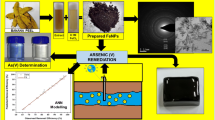Abstract
The magnetic iron nanoparticles (MFeNp) were biosynthesised using the extract of Cinnamomum tamala (bay leaf) and examined for its efficacy on sludge dewatering. The characteristics of MFeNp were studied using scanning electron microscope (SEM), transmission electron microscopy (TEM), x-ray diffraction (XRD), Fourier transform infrared spectroscopy (FTIR) and x-ray photoelectron spectrometer (XPS) techniques. The presence of polyphenolic compounds were confirmed by FTIR and XPS analysis. The reduction in capillary suction time (CST) (71.36 to 16.5 s) and specific resistance to filtration (SRF) (53.71 × 1011 to 1.47 × 1011 m/kg) values have indicated that the use of Fenton nanocatalyst enhanced the sludge dewaterability. The differential scanning calorimetry (DSC) analysis has shown that the mass of bound water in the treated sludge was decreased significantly from 1.45 to 0.92 kg H2O/kg DS. The breakdown of extracellular polymeric substances (EPS) by the MFeNp leads to the significant reduction in proteins, polysaccharides, water content and heavy metals. The optimisation using response surface modelling (RSM) have shown that the maximum removal efficiency of water from the sludge was 85.9 % when the optimum pH (3) MFeNp dosage (50 mg/g DS) and H2O2 dosage (500 mg/g DS) were maintained. The experimental results and the statistical optimisation have suggested that MFeNp can be used as a potential nanocatalyst for the sludge dewaterability and hence it can be used for the agricultural purpose.

Schematic representation of sludge dewatering process













Similar content being viewed by others
References
Angelo J, Perini DL, Fernandes R, Nogueira P (2016) Zero-valent iron mediated degradation of sertraline—effect of H2O2 addition and application to sewage treatment plant effluent. doi: 10.1002/jctb.4705
Bolobajev J, Trapido M, Goi A (2015) Improvement in iron activation ability of alachlor Fenton-like oxidation by ascorbic acid. Chem Eng J 281:566–574. doi:10.1016/j.cej.2015.06.115
Cao H, Polansky MM, Anderson RA (2007) Cinnamon extract and polyphenols affect the expression of tristetraprolin, insulin receptor, and glucose transporter 4 in mouse 3T3-L1 adipocytes. Arch Biochem Biophys 459:214–222. doi:10.1016/j.abb.2006.12.034
DuBois M, Gilles KA, Hamilton JK, et al. (1956) Colorimetric method for determination of sugars and related substances. Anal Chem 28:350–356. doi:10.1021/ac60111a017
Feng J, Yu S, Li J, et al. (2016) Enhancement of the catalytic activity and stability of immobilized aminoacylase using modified magnetic Fe3O4 nanoparticles. 286:216–222
Frølund B, Palmgren R, Keiding K, Nielsen PH (1996) Extraction of extracellular polymers from activated sludge using a cation exchange resin. Water Res 30:1749–1758. doi:10.1016/0043-1354(95)00323-1
Harshiny M, Iswarya CN, Matheswaran M (2015) Biogenic synthesis of iron nanoparticles using Amaranthus dubius leaf extract as a reducing agent. Powder Technol 286:744–749. doi:10.1016/j.powtec.2015.09.021
He D-Q, Wang L-F, Jiang H, Yu H-Q (2015) A Fenton-like process for the enhanced activated sludge dewatering. Chem Eng J 272:128–134. doi:10.1016/j.cej.2015.03.034
Kefeni KK, Msagati TM, Mamba BB (2015) Synthesis and characterization of magnetic nanoparticles and study their removal capacity of trace metals from acid mine drainage. Chem Eng J 276:222–231. doi:10.1016/j.cej.2015.04.066
Kuang Y, Wang Q, Chen Z, et al. (2013) Heterogeneous Fenton-like oxidation of monochlorobenzene using green synthesis of iron nanoparticles. J Colloid Interface Sci 410:67–73. doi:10.1016/j.jcis.2013.08.020
Kumar MPS, Phanikumar BR (2013) Response surface modelling of Cr6+ adsorption from aqueous solution by neem bark powder: Box-Behnken experimental approach. Environ Sci Pollut Res 20:1327–1343. doi:10.1007/s11356-012-0981-2
Lee CH, Liu JC (2000) Enhanced sludge dewatering by dual polyelectrolytes conditioning. Water Res 34:4430–4436. doi:10.1016/S0043-1354(00)00209-8 Sludge dewatering by dual polyelectrolyte
Lee D, Lee SF (1995) Measurement of bound water content in sludge : the use of differential scanning calorimetry (DSC): 359–365.
Liu H, Yang J, Zhu N, et al (2013) A comprehensive insight into the combined effects of Fenton’ s reagent and skeleton builders on sludge deep dewatering performance. 259:144–150. doi: 10.1016/j.jhazmat.2013.04.036
Lo IMC, Lai KCK, Chen GH (2001) Salinity effect on mechanical dewatering of sludge with and without chemical conditioning. Environ Sci Technol 35:4691–4696. doi:10.1021/es010834x
Marsalek R (2014) Particle size and zeta potential of ZnO. APCBEE Procedia 9:13–17. doi:10.1016/j.apcbee.2014.01.003
Miao F, Hua W, Hu L, Huang K (2011) Magnetic Fe3O4 nanoparticles prepared by a facile and green microwave-assisted approach. Mater Lett 65:1031–1033. doi:10.1016/j.matlet.2010.12.037
Mo R, Huang S, Dai W, et al. (2015) A rapid Fenton treatment technique for sewage sludge dewatering. Chem Eng J 269:391–398. doi:10.1016/j.cej.2015.02.001
Nadejde C, Neamtu M, Hodoroaba V-D, et al. (2015) Green Fenton-like magnetic nanocatalysts: synthesis, characterization and catalytic application. Appl Catal B Environ 176-177:667–677. doi:10.1016/j.apcatb.2015.04.050
Rtimi S, Pulgarin C, Sanjines R, Kiwi J (2015) RSC advances novel FeOx—polyethylene transparent films : synthesis and mechanism of surface regeneration. RSC Adv 5:80203–80211. doi:10.1039/C5RA14503A
Ruales-lonfat C, Barona JF, Sienkiewicz A, et al. (2015) Applied catalysis B : environmental iron oxides semiconductors are efficients for solar water disinfection : a comparison with photo-Fenton processes at neutral pH. Applied Catal B Environ 166-167:497–508. doi:10.1016/j.apcatb.2014.12.007
Shahwan T, Abu Sirriah S, Nairat M, et al. (2011) Green synthesis of iron nanoparticles and their application as a Fenton-like catalyst for the degradation of aqueous cationic and anionic dyes. Chem Eng J 172:258–266. doi:10.1016/j.cej.2011.05.103
Sharma V, Rao LJM (2014) An overview on chemical composition, bioactivity and processing of leaves of Cinnamomum tamala. Crit Rev Food Sci Nutr 54:433–448. doi:10.1080/10408398.2011.587615
Wang WY, Li AM, Zhang XM (2011) DSC and SEM analysis on bound water characteristics in sewage sludge. Adv Mater Res 347-353:2085–2089. doi:10.4028/www.scientific.net/AMR.347-353.2085
Zhang H, Yang J, Yu W, et al (2014) ScienceDirect mechanism of red mud combined with Fenton’ s reagent in sewage sludge conditioning. 9:2–10. doi: 10.1016/j.watres.2014.04.026
Acknowledgments
The authors would like to thank the VIT University, Vellore, for providing the necessary facilities and infrastructure to carry out this work. Further, the authors extend their gratitude to the reviewers for their valuable suggestions which helped in improving the quality of the work.
Author information
Authors and Affiliations
Corresponding author
Additional information
Responsible editor: Suresh Pillai
Rights and permissions
About this article
Cite this article
Ealias, A.M., Jose, J.V. & Saravanakumar, M.P. Biosynthesised magnetic iron nanoparticles for sludge dewatering via Fenton process. Environ Sci Pollut Res 23, 21416–21430 (2016). https://doi.org/10.1007/s11356-016-7351-4
Received:
Accepted:
Published:
Issue Date:
DOI: https://doi.org/10.1007/s11356-016-7351-4




